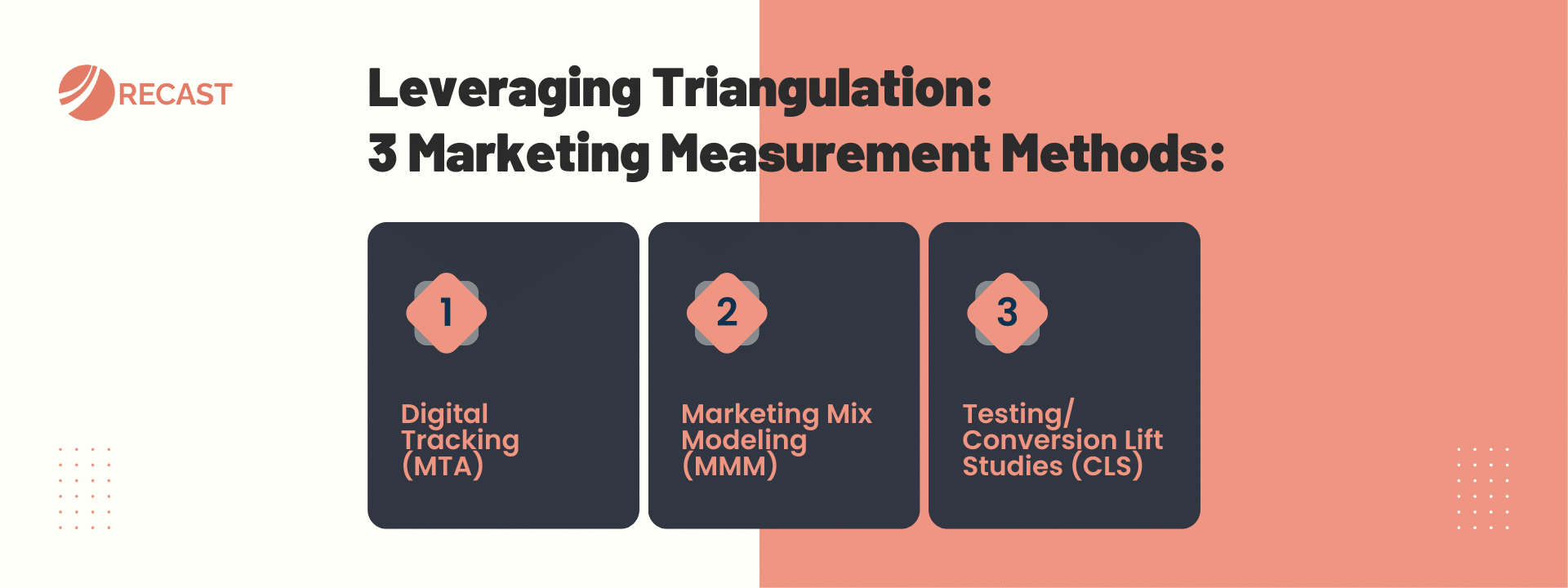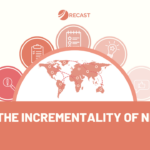There are three main ways that consumer brands measure marketing effectiveness: digital tracking (MTA), marketing mix modeling (MMM), and testing/conversion lift studies (CLS). For the last few years, we’ve lived in a world where most consumer brands didn’t have to think too much about this – they got away with using multi-touch attribution, and it worked well enough.
But those days are over. With digital tracking breaking, brands are now looking at the other measurement methods and considering whether they should switch and which one is best for them.
Our POV: no single data source will have the full truth. Incrementality is hard to find by using just one of these methods.
Every method has unique capabilities, limitations, and use cases so, even though we’re an MMM vendor, we recommend that, if you want to zero in on the truth of what’s working in your marketing, you need to use these methods in conjunction.
We call this process “triangulation,” and we think it’s the modern way of thinking about measurement. In this article, we will cover how to use each method and how to implement triangulation across the board.
The 3 Marketing Measurement Methods:
To leverage triangulation, you need a thorough understanding of the three marketing measurement methods. Let’s cover their strengths and weaknesses:
1. Digital Tracking (MTA)
Digital tracking, also known as multi-touch attribution (MTA), is the default method for online marketing effectiveness measurement. It relies on browser cookies, UTM codes, tracking pixels, or similar identifiers to track the marketing sources that lead to customer conversions.
Good for: granular insights and detailed data on individual touchpoints, real-time optimization, and MTA that acknowledge the influence of multiple channels throughout the customer journey.
Limited by: it relies heavily on cookies which is a capability that is quickly losing effectiveness and it has data privacy concerns that will lower its performance and make it hard to trust.
2. Marketing Mix Modeling (MMM)
MMM is a statistical modeling technique that analyzes historical data to determine which channels in their marketing mix deserve credit for sales in order to reallocate the budget to the highest-performing channels.
Good for: getting a holistic view of both online and offline marketing channels, long-term budget allocation planning, and it’s privacy-friendly because it relies on aggregate data.
Limited by: lag in data availability (though we’ve reduced to models that update weekly), not a lot of granular data, and models that are just hard to get right.
3. Testing/Conversion Lift Studies (CLS)
Testing or conversion lift studies (CLS) involve running experiments to measure the impact of marketing actions on sales. Geo-testing and holdout tests are some examples of CLS.
Good for: getting causal insight to determine the direct impact of specific marketing actions, real-world validation, and granular analysis.
Limited by: limited scope and not capturing the broader impact of all marketing efforts, they are costly to run well and they often take time to prepare and set up.
How do we get these methods working together?
We’ve built a database of 42 top consumer brands to see what measurement methods they use. One thing we learned is that over 40% of the brands in the database are using at least two methods together, and around 20% use all three. The best brands don’t pick one method to measure their performance, they triangulate.
So, how do we bring the whole story together?
We build on the strengths that every method brings us and limitate the weaknesses by leveraging other methods’ strengths. Here’s what that looks like:
- Use multi-touch attribution to get directional data for small daily optimizations like turning off a poor-performing ad or adjusting campaign settings. While you can set up your budget for each channel using MMM, it won’t zoom in too well to the tactic level. MTA with platform reporting does just fine for these.
- Use your model (MMM) to forecast different budget allocations between channels, determining how much you can spend in a channel before you see diminishing returns. To improve your model, use MMM in conjunction with conversion lift studies so you can compare against them.
- Run lift tests (CLS) every few months, and use the results to calibrate the accuracy of your MMM. You probably won’t run CLS often because they’re expensive, but the ones you run will help you get closer to true incrementality. Do more of them as your budget increases.
Here’s how this might look in practice:
- If your budget is $1 million a year, with 80% spent on Google Ads, you could run lift tests for that channel quarterly, with your smaller channels (TikTok) tested annually.
- Your last lift test told you Google Ads had an incremental cost per signup of $20, so you keep working on your MMM until it says the same for that time period.
- Your model estimates that TikTok is only counting 80% of the conversions it actually generates, so when it reports a $27 CPA it’s really achieving a $22 CPA.
TLDR:
Every measurement method gives you a different view of true performance, but if you put all the pieces together you can get as close as possible to incrementality. Triangulation can give marketers a more holistic view and help them make informed decisions, optimize their marketing mix, and allocate resources effectively.
Just as seeking a second opinion from a doctor helps make better decisions, leveraging multiple measurement methods through triangulation helps brands uncover the truth behind what works in marketing.



